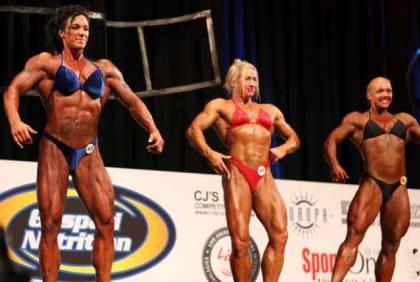FEMALE MUSCLE


Can Tall People Get Huge
Q. Being a tall athlete, do you modify your leg-training exercises, or do you stick to the basics (e.g., squats)?
A. The simple answer to this question after years of trial and error is “I listen to my body.” When I first began training seriously for competition, I made the typical mistake of focusing on weight lifted versus the muscles working. Whether you’re lifting for strength (1RM) or shaping your body (bodybuilding or figure), you need to practice proper form before advancing on the weight. Unfortunately for a lot of beginners, a lot of one-dimensional trainers in the gym think there’s only one road to the desired goal—squat heavy—and this myth is perpetrated all over the Internet. Not true!
Here’s the real deal: Yes, squats do build muscle. But if you’re squatting with your knees pushing forward over your toes, precariously balanced on your toes with all the weight hinging on your joints and lower back, there won’t be much muscle growth going on. You may feel tired when you leave the gym, but you won’t have done much for muscle growth. You’ll also reach a sticking point (or injury) where all the improper form in the world will not replace the need for real muscular strength. And believe me, you don’t want the incremental long-term joint and soft tissue damage that happens due to poor form.
If you’re a tall athlete, I recommend the following process to either learn to squat or decide to eliminate them from your repertoire:
1. Learn proper form from an experienced trainer or look online for instructional videos. Take note of the details, i.e., where the knees line up, the angle of the body, and the placement of the arms and elbows.
2. Practice the form every week with a moderate weight and learn to feel the muscles working in synergy. If you have long legs, you may do better with sumo squat form, so practice this as well. Don’t be concerned with the weight. Learn to “feel” the movement.
3. If after a couple of months of concentrated “learning” effort, you’re consistently experiencing joint or back pain, visit a chiropractor and massage therapist. Again, if this doesn’t help, and you’re certain your alignment is correct, I would highly recommend seeing a doctor to make sure you are not endangering yourself or do not have a pre-existing structural issue (scoliosis, bulging discs, etc). You wouldn’t want to be continuing to put strain on a damaged area. Pain is an indicator, and smart athletes listen to their bodies.
For those of you who have practiced the above and believe squatting has more risks than benefits, plenty of other exercises are just as effective when used with the proper intensity. I’ve squatted off and on during the last 15 years and usually it has been more off than on due to my spinal issues! Yet I still see my legs grow and mature each season. Again, proper form and a meticulous attention to detail are important. I do a lot of isolateral work, slow paced, pause reps, and a long time under tension. The key is to learn to put the load of weight on the muscle and not on the joint. Don’t make the mistake of thinking that when you enter the gym you can just turn off your brain and throw the weight around. Know what you’re trying to work, understand the physiology of the muscle, and focus on where your weak areas are and put your attention there rather than your ego.
For tall athletes, or those who are working around existing injuries, here is a list of some possible leg training options for you:
1. Leg press—feet placed high (glutes/hams), feet placed low (quads), wide stance toes out (plie), pause reps (dead weight on the bottom safety), one-legged (upper or lower). Use slow negatives, explosive reps, high reps, and low-rep partials.
2. One- or two-leg V-squat or lying squat machine (hack). Using one leg will usually put less stress on the lower back.
3. One-leg lunge with rear leg elevated (Smith machine, dumbbells, barbell). Push the hips back and focus on the forward leg.
4. Sumo Smith machine squats (leaning).
5. One-leg squats on a plyo box. Practice these with a towel around a bar to assist you for the first few weeks. As you get stronger, you can hold a kettlebell for added resistance.
6. Front barbell or Smith machine squats. Often, front squats are easier for tall athletes or those with back/spine issues.
Remember to work on your time under tension, create a pause at each point at the top and bottom of the exercise to ensure there is no momentum, clearly focus on the muscle being worked, and remember that growing muscle or changing the shape of your body requires more smarts than ego!

